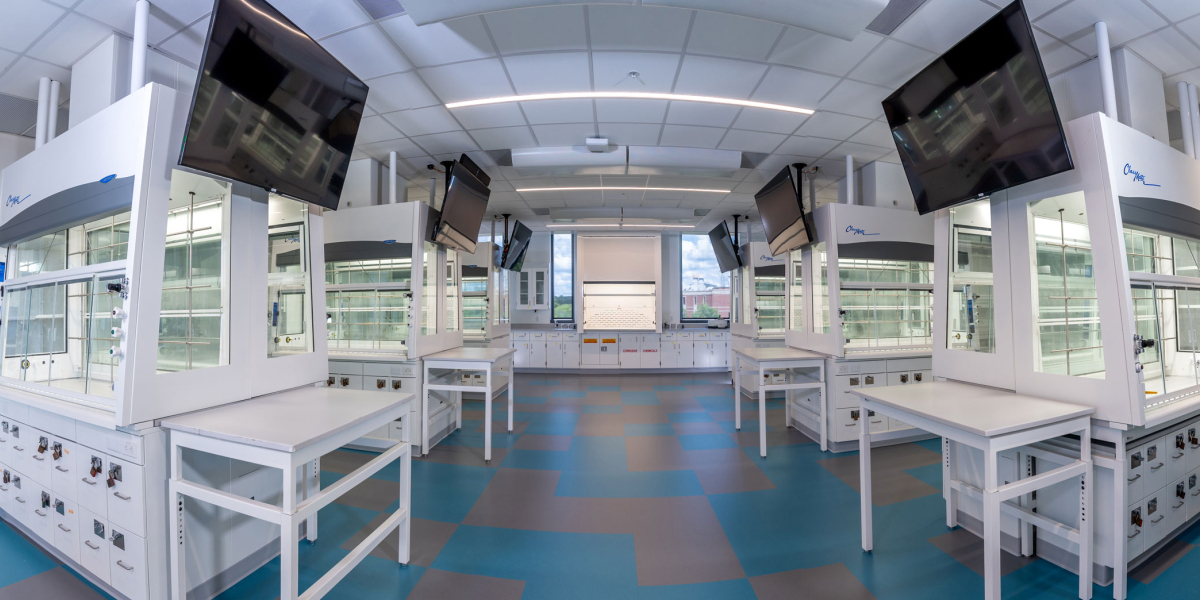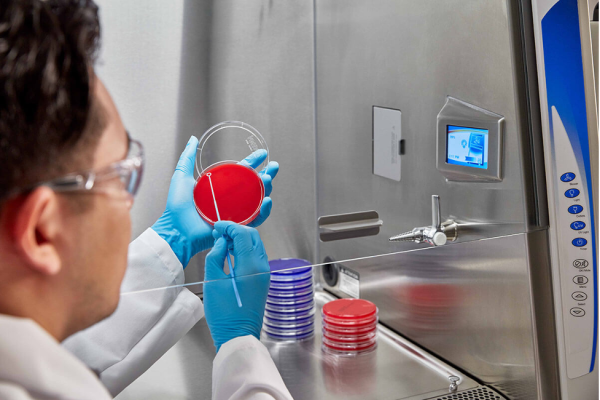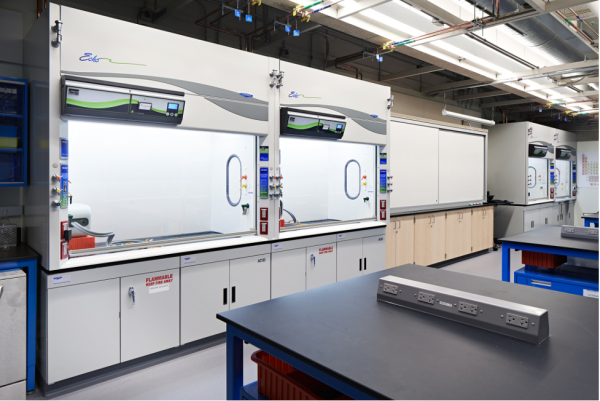Lab Design - Where to Begin

Whether designing a lab from the ground up or working with an existing structure, every lab design must accommodate input from a vast array of contributors: architects, engineers, contractors, managers, administrators and most importantly, the end users. The design must take into account the perspectives of the diverse scientists that will spend countless hours in the facility. What driving principles should be considered? Good design fundamentals dictate that form should follow function, but can this realistically be achieved with ever-changing government regulations, environmental sensitivities, space challenges and basic human needs? Achieving a balance is no easy task. In this article we’ll explore lab design ideas that are tried and true, those that are trending, and factors that must always be a part of any laboratory design undertaking.
New Tools of the Trade
Augmented reality (AR), virtual reality and immersive technology are increasingly being applied to test design concepts prior to construction, providing important feedback. AR assessments can yield valuable information before expensive decisions are made. By relating lab needs to specific lab products, PPE, engineering controls, equipment, etc. and considering their distribution in a physical lab, space considerations can be formulated. Adding in the workflow, the safety components and the sequences required in performing the processes that will take place in the lab yields another layer of information. Through digital modeling, the lab can be viewed and experienced virtually, giving designers insight into the true impact and consequences of structure and furniture placement. With this immersive technology, workflows and equipment placement can be optimized before installation.
The Stakeholders Today are Not the Lab Users of Tomorrow
A key factor often overlooked in lab design is that those making the project decisions are often no longer at the facility or institution ten years after installation. Their decisions make an impact far longer than they intended. Planning for current needs as well as less predictable future needs is always an important consideration. Building and design costs are obvious; however, future costs based on planned and imagined usage should be incorporated into every aspect of the build, especially when laboratory furniture can contribute significantly to the operational cost of a lab. For this reason, laboratory designs should be configured for flexibility and scalability to allow for growth or the ability to alter the space as application needs change.
Commitment to Continual Learning
When possible, the design and construction of a laboratory should incorporate a designated area for observers so the health and safety of the viewer and the lab worker is never compromised. Even those that are not at educational institutions often have stakeholders that are interested in the inner workings of the lab. Many new labs incorporate tour-friendly areas or designated observation sites to separate the lab work from interested parties and keep the environment manageable and safe from contamination.
Ergonomics
According to Clay Stafford and Jeffrey Owens of HERA Lab Planners, scientists spend 60-80% of their time in the lab. Because of this, traditional metrics used to approach lab design are being redefined. Alternative measurements for research productivity include a new normal of remote working, generational shifts, and an overall human-centric approach to research and technology.
Improved ergonomics is a necessary component for any successful lab. Some features that are being incorporated into the design of top tier laboratory equipment include angled sashes and new window designs on biosafety cabinets, improved visibility and access to work surfaces, as well as materials that are easier to clean and disinfect. Advanced technology is available, and desired, to optimize research outcomes. Some newer equipment includes remote monitoring, which allows scientists to move to other parts of the lab, building or even off premises, while also improving efficiency.

Another trend in lab design is that office space has moved closer to the laboratory itself. For example, in The California Air Resources Board (CARB) laboratory, a 2022 Lab Manager Design Excellence Award winner, one of the design goals was to place offices within a 15 second walk from the lab work being conducted, to ease stresses on those doing the work. Workflows performed at optimal placement ensure efficiencies for both working personnel and the overall form and function of the facility.
Mobility
Laboratories need to be able to pivot and quickly adapt to new demands. One example of innovation implemented to improve efficiencies was the introduction of Labconco’s Echo® Filtered Fume Hood, used in the construction of the Science Center on Science Hill at Wellesley College. Ductless fume hoods are an environmentally safe option that offer flexibility in a lab that will likely go through changes and modifications over the years. These valuable resources can literally be redistributed and the workflow in the lab can be reconfigured if needed.
At Wellesley College, temporary chemical labs in modular buildings were needed while the new laboratory was being constructed. The filtered fume hood design resolved the immediate teaching issue, and these fume hoods became fixtures in the new laboratory due to their energy efficient technology, saving the college nearly $200,000 a year in energy consumption and maintenance.

Takeda Biologics Facility (previously Shire Biotechnology Company), in Covington, Georgia constructed a state-of-the-art lab prior to the pandemic with mobile benches and overhead service carriers. The carriers provide workstations with the power and gases needed throughout the lab. Now, overhead service carriers are common to many labs. Laboratory furniture and work benches are now often on wheels.
Lab planners are embracing the idea that mobility and flexibility are critical to growth. Labs designed with the understanding that safety features change throughout time are more easily able to meet safety challenges when they arise. Modular design lends to adaptation and ultimately increased productivity.
Health & Safety Considerations
According to safety expert Dan Scungio, a culture of safety is missing in many labs. Known as “Dan the Lab Safety Man,” he has over 30 years of experience as a certified Medical Technologist and is a highly recruited laboratory safety consultant from Sentara Healthcare. Scungio asserts that most lab members are not focused on common, everyday safety hazards. Personal Protective Equipment (PPE) is one such problem, in that people often do not follow protocol during off-shifts; removing masks to post pictures on social media, allowing food and beverages in the lab, cell phone contamination, etc. Preventing unsafe behavior can be achieved by providing equipment that protects from the hazards and designing spaces adjacent to work areas that are clearly defined as safe spaces. OSHA mandates that PPE must be based on a risk assessment of the laboratory and donning and doffing of PPE is often overlooked in the space needed for workflow and use.
Another safety consideration is the storage of chemicals. Considerable space needs to be defined for the separation of acids and bases. Flammable chemicals have specific space requirement and containment criteria based on the number of gallons on premises. An obvious consideration often overlooked is that chemicals should be stored low to the ground so lab workers don’t have to reach up to pull down a chemical. Cost-effective solutions to everyday hazards start with planning. Preanalytical safety will go a long way in providing a workplace that is less prone to accidents.
Environmental Considerations
Managing balanced, uninterrupted airflow in life science and biology labs is key to not only managing costs but to reducing overall energy consumption and having minimal environmental impact. Reducing carbon footprints is no longer trendy; it is expected and necessary. There are technologies available now that are hyper-sensitive to airside efficiencies, such as Labconco’s Protector XStream I-S Fume Hood. Intelligent fume hood systems can detect and adjust face velocities based on sash movement, and now hoods can be designed with automated sashes that reduce air exhaust when the hood is left unattended. Advanced programmable operating systems allow for expert calibration so that prescriped minimum air changes occur while maximizing safety. As mentioned earlier, filtered fume hoods such as those using Erlab’s Neutrodine· Unisorb Filtration Technology are capable of comprehensive molecular filtration. With tools like these, meeting demanding green building goals is possible.
Clearly Defined Lab Spaces in Conjunction with Multi-Purpose Areas
A winner of Lab Manager’s 2022 Excellence in Innovation Design Excellence Award was the Caltech Chen Neuroscience Research Building. This lab shared a common design element with several others featured in the Lab Design Summit; increasingly, new labs are being constructed with multiple levels built around a central spine. The spine, or central corridor, not only has the important role as a connective space, but is a flex space that can be used for delivery, storage and spillover. Use of corridors as deliberately planned multipurpose spaces is trending.
Multi-floor laboratories are often choosing which floors are most suitable for specific activity based on vibration, noise and hazards, which can be completely different from one lab to the next. Newer designs incorporate multi-purpose areas where staff can access large amounts of consumables, such as chemicals and supplies, that can also serve as receiving areas for samples or shipments. Private offices, write-up areas and collaborative spaces, as mentioned earlier, are thoughtful nods to how humans interact in this type of work environment.
One common element that current lab design projects are focused on is optimizing light. Open-space concepts are preferred and when windows are generous, natural light can completely fill a workspace. Maximizing visibility where possible is highly encouraged and preferred by the scientists who spend most of their time in the lab. Of course, this type of design element can be costly. Harnessing light and using it correctly is tricky, and the heat generated by natural light and the climate can be expensive to overcome. The orientation of the building is a critical consideration as well. Daylighting is known to increase productivity and enhance performance proving to be a necessary design consideration.
Net Zero Energy (NZE) Labs
Operational efficiency is the impetus for net zero energy labs. Yes, as stewards of this planet, the NZE (sometimes called ZNE) conversation has benevolent underpinnings, but the biggest advantage is obviously cost savings. If a laboratory can produce the same amount or more energy than it uses and mitigate environmental hazards, then it is a win-win for the climate and the budget.
In the Material for Energies Program at the Argonne National Laboratory, Mathew Ficket, SGA, recommends all-electric lab buildings because they are easier to operate, cleaner for the environment and not influenced by sharply fluctuating energy prices. Through the use of the environment, the major features of laboratory buildings can inform the project’s deliverable goals, as in creating energy for the lab. Use of solar panels is one example of using materials to create energy. Quality assured products within the lab play a huge role as well, such as shielding and ventilation components. The most efficient equipment must be considered. HEPA filtered exhaust is a must, especially with microbiological, biomedical and radiological facility labs.
NZE labs are the apex in sustainable lab design, but the resources used by laboratories are tremendous. Without the assist from the environment in the form of solar, wind, hydro, etc. this type of lab is out of reach for most. Fortunately, where there’s a will, there’s a way and monetary motivations combined with our natural sense to protect the planet will continue to move this needle forward.
Takeaways
The scientific community will always embrace progress and change. Most laboratory users welcome new information, crave learning and are inspired to tackle the tough problems that science continues to deliver. Just like any other industry, these people desire to work in the best possible spaces with the most advanced equipment. They want to be comfortable, and they want their work areas to serve them. Workflow functionality and safety are of course the two primary concerns for any lab design project, but the labs that will continue to deliver decades from now will stand apart because they are thoughtfully designed with flexibility and scalability incorporated into the planning process. Labs that are ergonomically intuitive through lighting, furniture, equipment, layout and processes will simply become expected. And lastly, efforts to improve sustainability are welcomed and supported by all.
Learn more about the Future of Innovation in Lab Design in this webinar by Ryann Rios of Labconco as she explores the history of today’s modern lab and trends for the future.
References
- Carlisle, Nancy, A.I.A., National Renewable Energy Laboratory, Laboratories for the 21st Century: Best Practices, On Daylighting, 2003
- Cole, Martin, Product Manager, Thermo Fisher Scientific, American Laboratory, Volume 50, Number 4, May 2018
- Ficket, Matthew, SGA, Net Zero Labs, Lab Manager Digital Design Summit, July 16, 2022
- Kramer, Brad, Project Development Manager, Labconco, Lab Design Interview, July 26, 2022
- Owens, Jeffrey, and Clay Stafford HERA Laboratory Planners, Redefining the Future of Lab Facilities, Lab Manager Design Digital Summit, June 14, 2022
- Ryan, Kevin, Designing a Lab, Lab Manager, Volume 12, No. 6, 2017
- Savage, Luke, Director of Ventilation Technology, Labconco, Lab Design Trends, August 8, 2022
- Scungio, Dan MT(ASCP), SLS, CQA (ASQ). Fisher Healthcare Webinar, Top Ten Healthcare Laboratory Safety Hazards, June 1, 2022
| chevron_left | Laminar flow in the laboratory: What you need to know | Articles | Class II, Type C1 Biosafety Cabinet: Versatility, Safety & Savings Comparison | chevron_right |






